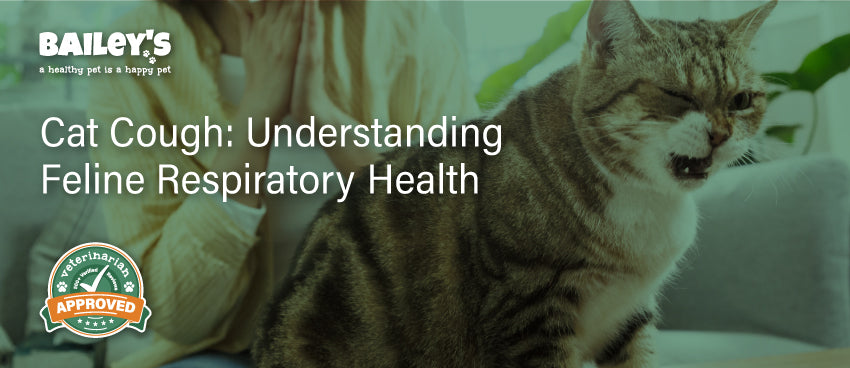Cat Cough: Understanding Feline Respiratory Health

Coughing in cats, while common, can often signal an underlying health issue. As diligent pet owners, it's essential to understand the nuances of feline respiratory health and identify potential concerns promptly. This not only ensures timely care but also enhances the quality of life for our beloved feline friends.

In collaboration with the expert team at Bailey’s CBD , we'll dive into key aspects of cat respiratory health: recognizing the signs of a cat cough, understanding its causes, diagnosing it accurately, and exploring effective treatment strategies to ensure your cat’s well-being.
Table of Contents
1. The Basics of Feline Respiratory Health
Understanding the anatomy and common respiratory functions of a cat is fundamental in recognizing respiratory issues. The respiratory system is crucial for a cat's overall health, as it helps them breathe and maintain oxygen levels in their body.
When it comes to the anatomy of a cat's respiratory system, there are several key components to consider. These include the nose, throat, windpipe, voice box, and lungs. Each of these components plays a vital role in the process of respiration and can be affected when respiratory issues arise.
The nose, for example, serves as the entry point for air into the respiratory system. Cats have a highly developed sense of smell, and their noses are equipped with specialized olfactory receptors that allow them to detect various scents in their environment. The nasal passages are lined with tiny hairs called cilia, which help filter out dust and other particles before the air reaches the lungs.
Connected to the nose is the throat, also known as the pharynx. This muscular tube serves as a passageway for both air and food. When a cat breathes, the air passes through the throat and into the windpipe, or trachea. The trachea is a flexible tube made up of cartilage rings that help keep it open and prevent it from collapsing.
At the base of the trachea lies the voice box, or larynx. This is where the vocal cords are located, allowing cats to produce various sounds and communicate with their owners. The larynx also plays a role in protecting the airway by closing off during swallowing to prevent food or liquid from entering the lungs.
Finally, we have the lungs, which are the main organs responsible for respiration. Cats have two lungs, located in the chest cavity, and they are divided into lobes. The lungs are made up of millions of tiny air sacs called alveoli, where the exchange of oxygen and carbon dioxide takes place. Oxygen is taken in by the lungs and transported to the rest of the body via the bloodstream, while carbon dioxide, a waste product, is expelled from the body through exhalation.
1.1 Common Respiratory Functions in Cats
Cats use their respiratory system for breathing, smelling, and vocalizing. Proper functioning of the respiratory system allows cats to engage in normal activities such as playing, hunting, and communicating with their owners.
When it comes to breathing, cats have a unique respiratory pattern. Unlike humans, who primarily rely on their diaphragm for breathing, cats predominantly use their rib muscles. This allows them to take quick and shallow breaths, which is especially useful during physical exertion or when they need to conserve energy.
Smelling is another important respiratory function for cats. Their highly developed sense of smell helps them navigate their environment, locate prey, and identify potential dangers. Cats have a specialized organ called the vomeronasal organ, or Jacobson's organ, located in the roof of their mouth. This organ allows them to detect pheromones and other chemical signals, providing them with valuable information about their surroundings.
Lastly, vocalizing is a common respiratory function in cats. Whether it's a meow, purr, hiss, or growl, cats use their respiratory system to produce a wide range of sounds. Vocalizations serve as a means of communication, allowing cats to express their needs, emotions, and intentions to their owners and other feline companions.
2. Identifying a Cat Cough
Recognizing a cat cough can be challenging, especially since cats are known for their ability to hide signs of illness. However, by paying attention to their behavior and the sounds they make, it is possible to identify when a cat is coughing.
When it comes to our feline friends, it's important to be vigilant and observant. Cats are masters at concealing their discomfort, often masking their symptoms until they become more severe. This is why identifying a cat cough requires a keen eye and a careful ear.
One of the first steps in recognizing a cat cough is understanding the difference between normal and abnormal cat sounds. Cats have a wide range of vocalizations, each signifying different emotions or needs. Normal sounds include the gentle purring that we all love, the occasional meow for attention, and even the occasional sneeze. These sounds are a part of their everyday communication and are nothing to be concerned about.
However, abnormal sounds may consist of wheezing, gagging, or harsh coughing. These sounds are often more pronounced and can be a cause for concern. If you notice your cat making these types of sounds, it is essential to pay attention and investigate further.
Aside from the sounds they make, other signs may also indicate a cat cough. Cats, like humans, may frequently clear their throats when they have a cough. If you notice your cat doing this more often than usual, it could be a sign that they are experiencing respiratory discomfort.
Another common sign of a cat cough is coughing up hairballs. While hairballs are a normal part of a cat's grooming routine, excessive coughing and retching could indicate an underlying issue. It's important to monitor the frequency and severity of hairball episodes to determine if they are related to a cough.
In addition to throat clearing and hairball episodes, difficulty breathing is another sign that your cat may be coughing. If you notice your cat struggling to breathe or if their breathing sounds labored, it is crucial to seek veterinary attention immediately. Difficulty breathing can be a symptom of a more serious respiratory condition that requires prompt medical intervention.
Lastly, changes in appetite or behavior can also be indicators of a cat cough. Cats are creatures of habit, and any sudden changes in their routine should be taken seriously. If your cat is coughing and also experiencing a loss of appetite, lethargy, or a change in their usual behavior, it's important to consult your veterinarian for a proper diagnosis and treatment plan.
Simply stated, identifying a cat cough requires careful observation and attention to detail. By understanding the difference between normal and abnormal cat sounds, paying attention to other signs such as throat clearing, hairball episodes, difficulty breathing, and changes in appetite or behavior, you can determine if your cat is indeed coughing. Remember, when in doubt, it is always best to consult your veterinarian for a professional evaluation and guidance.
3. Causes of Cat Cough
Several factors can contribute to a cat coughing, ranging from respiratory infections to environmental triggers and underlying health conditions. Identifying the underlying cause of a cat cough is crucial in determining the appropriate treatment.
A cat's respiratory system is complex and delicate, making it susceptible to various issues. Understanding the different causes of cat cough can help pet owners recognize when their feline companion is experiencing respiratory distress.
3.1 Respiratory Infections in Cats
Respiratory infections, such as feline upper respiratory infection (URI), are a common cause of cat cough. URI is highly contagious, and cats that spend time in shelters, catteries, or multi-cat households are particularly prone to contracting these infections.
URI is caused by a combination of viruses and bacteria, including feline herpesvirus and feline calicivirus. These pathogens attack the respiratory system, leading to symptoms like coughing, sneezing, nasal discharge, and fever. Kittens and older cats with weakened immune systems are especially vulnerable to respiratory infections.
When a cat is diagnosed with a respiratory infection, prompt treatment is essential to prevent complications and alleviate discomfort. Veterinarians may prescribe antibiotics, antiviral medications, and supportive care to help the cat recover.
3.2 Allergies and Environmental Factors
Just like humans, cats can also be affected by allergies and environmental factors that may lead to a cough. Pollen, dust mites, cigarette smoke, and certain chemicals can trigger an allergic response in cats, resulting in respiratory issues.
Allergic reactions in cats can manifest as coughing, wheezing, sneezing, and difficulty breathing. It is important for pet owners to identify and minimize exposure to allergens in their cat's environment. This may involve keeping the house clean, using air purifiers, and avoiding smoking indoors.
In some cases, a veterinarian may recommend allergy testing to pinpoint the specific allergens causing the cat's symptoms. Treatment options for allergies in cats may include antihistamines, corticosteroids, or allergen-specific immunotherapy.
3.3 Underlying Health Conditions
In some cases, a cat cough may be a symptom of an underlying health condition such as asthma, heart disease, or lung tumors. These conditions require a thorough diagnosis from a veterinarian to develop the most appropriate treatment plan.
Asthma is a chronic respiratory condition that can cause coughing, wheezing, and difficulty breathing in cats. It is often triggered by allergens or irritants in the environment. Treatment for feline asthma may involve medications to control inflammation and open up the airways.
Heart disease can also lead to coughing in cats. Conditions such as hypertrophic cardiomyopathy or congestive heart failure can cause fluid to accumulate in the lungs, leading to coughing and difficulty breathing. Treatment for heart disease in cats may include medications to manage symptoms and improve heart function.
In rare cases, a cat cough may be a result of lung tumors. These tumors can be benign or malignant and can cause respiratory symptoms such as coughing, wheezing, and weight loss. Treatment options for lung tumors in cats may include surgery, chemotherapy, or radiation therapy, depending on the type and stage of the tumor.
It is important for cat owners to consult with a veterinarian if their cat is experiencing a persistent cough or any other respiratory symptoms. A thorough examination and diagnostic tests can help determine the underlying cause and guide appropriate treatment. Your furry feline’s favorite veterinarian can help you determine if supplements or medications can help alleviate issues.

4. Diagnosing a Cough in Your Cat
When it comes to diagnosing a cough in your cat, it is essential to consult a veterinarian who can conduct a thorough examination and perform diagnostic tests to determine the underlying cause of the cough.
4.1 Veterinary Examinations and Tests
A veterinarian will typically start by conducting a physical examination, listening to the cat's lungs and heart, and taking a detailed medical history. Depending on their findings, they may recommend additional tests such as bloodwork, X-rays, or respiratory fluid analysis to further evaluate the cat's condition.
4.2 Interpreting Your Cat's Symptoms
Interpreting your cat's symptoms is crucial in assisting your veterinarian in making an accurate diagnosis. Be sure to provide detailed information about your cat's cough, including when it started, how often it occurs, and whether there are any noticeable triggers or accompanying symptoms.
5. Treatment Options for Cat Cough
Once the underlying cause of a cat cough is identified, a veterinarian will recommend specific treatment options that aim to alleviate the symptoms and address the underlying condition.
5.1 Medications and Therapies
Depending on the cause of the cough, your veterinarian may prescribe medications such as antibiotics for respiratory infections, anti-inflammatories for allergic responses, or bronchodilators for asthma. In certain cases, additional therapies such as oxygen therapy or nebulization may be recommended to provide relief.
5.2 Home Care Strategies
Alongside medication, implementing home care strategies can help manage a cat's cough. This may include providing a clean and dust-free environment, using air purifiers, and avoiding exposure to known triggers. Additionally, maintaining good overall cat health through a balanced diet, regular exercise, and prompt veterinary care can also contribute to respiratory well-being.
Overall, understanding feline respiratory health is crucial for effectively managing cat cough. By recognizing the signs, identifying the causes, seeking proper diagnosis, and following the recommended treatment options, we can ensure our feline companions live a comfortable and healthy nine lives.











